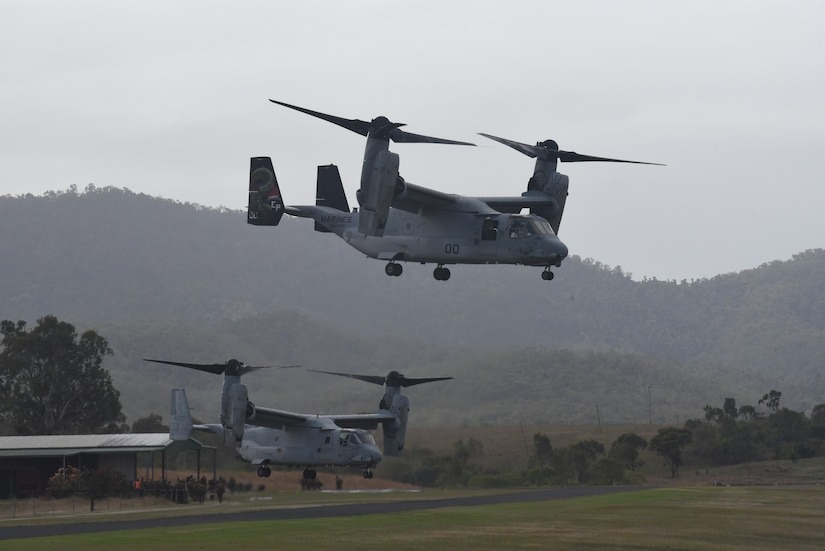
Release from the U.S. Department of Defense
*****
Marine Infantry Packs a Logistics Punch on Australian Beach
July 27, 2023 | By David Vergun , DOD News
Several hundred U.S. Marine Corps infantrymen of the 31st Marine Expeditionary Unit landed yesterday on the beach at Midge Point in Queensland, Australia.
With them were trucks, spare parts, mechanics, fuel, communications gear and everything else needed to support the infantry in a fight as part of Exercise Talisman Sabre 2023 — the U.S.-Australia exercise that included a dozen other partner nations.
During the first decades of the 21st century, Marines and other forces in Iraq and Afghanistan relied on massive logistics sites, known as “iron mountains,” for beans, bullets, bandages and everything else needed to conduct operations, said Marine Corps Lt. Col. Matt Verdin, commander of Combat Logistics Battalion, 3rd Battalion, 1st Marine Regiment, based at Camp Pendleton, California.
Not anymore, he said.
When Marines came ashore in Navy landing craft air cushions, or LCACs as they are better known, they took with them all the supplies and other materiel needed to push inland against entrenched enemy forces in the exercise scenario, he said.
It’s getting back to the roots of what the Marine Corps does best, he said: sustaining themselves in austere, contested environments and moving quickly to secure objectives without waiting for the logistics tail to catch up to the fighters.
Exercises like Talisman Sabre bolster rapid crisis response capability that has been a Marine Corps hallmark for centuries, he said.
This year marks the 10th iteration of Talisman Sabre, a biennial exercise designed to advance a free and open Indo-Pacific by strengthening partnerships and interoperability among key allies. The spelling of the name — sabre vs. saber — reflects which country is leading the exercise: Talisman Sabre when Australia leads and Talisman Saber when the U.S. leads.
Marines who landed yesterday had sailed from Okinawa, Japan, aboard the amphibious transport dock ships USS Green Bay and USS New Orleans. Accompanying those vessels was the amphibious assault carrier USS America, the lead ship of the America Amphibious Ready Group.
Landing with the Marines were detachments from the Japan Ground Self Defense Force’s Amphibious Rapid Deployment Brigade and a German naval infantry from the Bundeswehr Sea Battalion.
Later in the day, Marines from the USS America landed further inland from Midge Point, arriving aboard V-22 Osprey aircraft. Those aircraft can land vertically like helicopters, but they fly much faster. Others landed in CH-53 helicopters. Upon landing, they all encountered an opposition force made up of Marines dressed in desert camouflage uniforms to identify them as “enemy.”
The V-22s were protected overhead by Cobra attack helicopters.
The America Amphibious Ready Group made a port visit last month to Brisbane, Australia, just to the south of where the landings took place.
The United Kingdom is also participating in Talisman Sabre. The U.S., U.K. and Australia comprise what’s known as AUKUS, which is a trilateral security pact formed in 2021.
“All of this is yet another reminder that our unbreakable alliance is capable of great things. It has, indeed, endured for generations, and it remains vital to regional peace and security,” Secretary of Defense Lloyd J. Austin III said of AUKUS earlier this year during a visit by Australian Deputy Prime Minister Richard Marles, who also serves as his country’s defense minister.
At that meeting, Austin said: “We also pledged to find new ways to work closely with Japan as we pursue a common vision of a free and open Indo-Pacific, as a region where all countries can chart their own course and all states respect international rules and norms and where all disputes are resolved peacefully.”
Austin met with British Defense Secretary Ben Wallace just weeks earlier.
- Red Sea Update - April 26, 2024
- U.S. Begins Construction on Temporary Pier to Deliver Humanitarian Aid to Gaza - April 26, 2024
- IKE Carrier Strike Group Arrives in the Eastern Mediterranean - April 26, 2024






